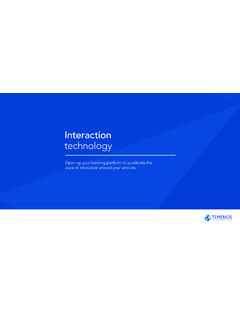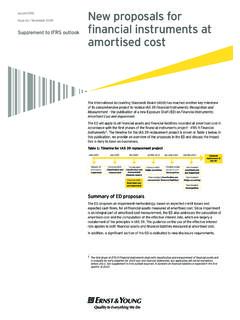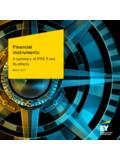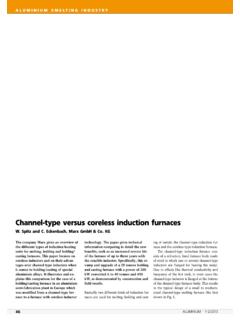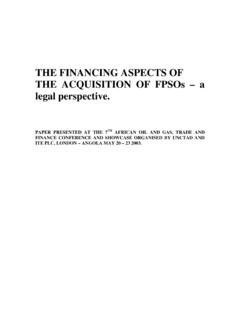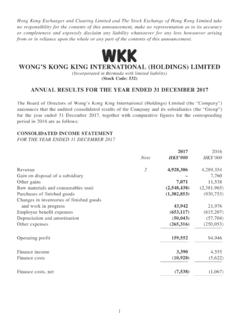Transcription of International Financial Reporting Standards 9 (IFRS 9)
1 International Financial Reporting Standards 9 (IFRS 9) Financial InstrumentsTemenos Briefing Document2 ContentsClassification and MeasurementImpairment AccountingHedge Accounting 060608040303 GlossaryOverview of IFRS 9 IFRS across the globe05 Crux of IFRS 905 Three main areas of IFRS 909 Strategy from Temenos for IFRS 9 How can Temenos help?Key offerings as part of the IFRS 9 solution in Temenos Core BankingAvailability of the IFRS 9 solution in Temenos Core Banking09091111 Contacts3 GlossaryAbbreviationDefinitionIFRSI nternational Financial Reporting StandardsAMCA mortised CostFVTPLFair Value Through Profit & LossFVTOCIFair Value Through Other Comprehensive IncomeEIRE ffective Interest RateECLE xpected Credit LossEADE xposure at DefaultLGDLoss Given DefaultPDProbability of DefaultCCCC ontractual Cash FlowsFAFinancial AssetFLFinancial LiabilityOverview of IFRS 9 The International Accounting Standards Board (IASB) has published a new IFRS 9 to address the shortcomings of the existing International Accounting Standard 39 (IAS39) by mandating a new method for applying risk metrics to accounting relating to the Financial Instruments.
2 The changes to Financial instrument accounting are likely to have the greatest impact on banks and other Financial package of improvements introduced by IFRS 9 includes the following: a logical model for classification and measurement; a single, forward-looking expected loss impairment model; and a substantially-reformed approach to hedge across the globeWorldwide more than 100 countries require, permit or are converging to IFRS. The changes to Financial instrument accounting are likely to have the greatest impact on the banks and other Financial that require or permit IFRS 9 Countries converging to IFRS with the goal of adoptionCountries pursuing convergence to IFRS 9 but no plan to adopt in the near futureCountryStatusUSUS GAAPJ apanConverging to IFRSUKIFRSF ranceIFRSC anadaConverging to IFRSG ermanyIFRSHong KongIFRSS witzerlandIFRS or US GAAPIFRS implementation status with the top global capital markets:5 The overview of the IFRS 9 project is summarized by the following analysis, answering the four important questions:Crux of IFRS 9 What?
3 IFRS 9 Financial Instruments introduces new guidance for: Classification and measurement Impairment accounting Hedge accounting Revised methodology for own credit riskWho?All banks and insurance entities Reporting according to IFRS need to comply with IFRS IASB published the final version of IFRS 9 Financial Instruments in July 2014. IFRS 9 will come into effect on 01 January 2018. However, the standard is available for early application for the Financial year beginning from 01 Jan 2017. Why? (business rationale)IFRS 9 Financial Instruments requires banks to move from an incurred loss model to an expected loss model. For the first time, banks will have to recognize not only credit losses that have already occurred but also losses that are expected in the addition, IFRS 9 addresses the so-called own credit issue, whereby banks and other Financial institutions book gains through profit or loss as a result of the value of their own debt falling due to a decrease in credit worthiness when they have elected to measure that debt at fair standard also includes a simplification of the classification and measurement categories for Financial assets and an improved hedge accounting model to better link the economics of risk management with its accounting main areas of IFRS 9 Classification and measurementHedge accountingImpairment accounting1236 Classification and measurementClassification determines how Financial assets are accounted for in Financial statements and, in particular, how they are measured on an ongoing basis.
4 Requirements for classification and measurement are the foundation of the accounting for Financial instruments. The requirements for impairment and hedge accounting are based on that 9 largely carries forward the scope of IAS 39. All Financial instruments that are in scope of IAS 39 are in scope of IFRS 9. IFRS 9 classification: is a principle based approach is based on business model and nature of cash flows is a business model driven re-classification own credit gains and losses presented in OCI for FVO liabilitiesMeasurement - Financial AssetsIFRS 9 applies one classification approach for all the Financial Assets including those that contain embedded derivative criteria s are used to determine how Financial asset should be classified & measured:1. the entity s Business Model for managing Financial Assets2. the Contractual Cash Flow Characteristic of the Financial AssetsFINANCIAL ASSETSB usiness Models for:ObjectiveAmortised Cost - AMCIs to hold assets in order to collect Contractual Cash Value Through Other Comprehensive Income - FVTOCIIs achieved by both collecting Contractual Cash Flows and selling Value Through Other Profit Loss A/c.
5 - FVPLAll other business models will follow - Financial LiabilitiesIAS 39 s treatment of Financial liabilities is carried forward to IFRS 9 essentially unchanged. This means that most Financial liabilities will continue to be measured at amortised cost. IFRS 9 includes the same option as IAS 39 that permits entities to elect to measure Financial liabilities at fair value through profit or loss if particular criteria s are met. Financial ASSETSB usiness Models for:ObjectiveAmortised Cost - AMCMore or less similar to IAS Value Through Other Profit Loss A/c. - FVPLI mpairment accountingThe three-bucket impairment model is a new requirement of IFRS 9, which will replace the existing Incurred Loss Model with the new Expected Loss Model. Drawbacks of the Incurred Loss Model of IAS 39 During the Financial crisis, there was a delayed recognition of credit losses on loans (and other Financial instruments) and this was identified as a weakness in the existing accounting Standards .
6 The existing model in IAS 39 (an incurred loss model) delays the recognition of credit losses until there is an evidence of a trigger event. As the Financial crisis unfolded, it became clear that the incurred loss model gave room to a different kind of earnings management, namely to postpone losses. Even though IAS 39 did not require waiting for actual default before impairment is recognized, in practice this was often the Expected Loss Model under IFRS 9It is a forward-looking expected credit loss model that will result in more timely recognition of loan losses and is a single model that is applicable to all Financial instruments subject to impairment accounting. It eliminates the threshold for the recognition of expected credit losses, so that it is no longer necessary for a trigger event to have occurred before credit losses are recognized. Consequently, more timely information is required to be provided about expected credit Concepts Expected Loss Model12 month Expected LossesPortion of lifetime expected credit losses that represent the expected credit losses that result from default events on a Financial instrument that are possible within the 12 months.
7 After the Reporting dateLifetime Expected LossesCredit losses are an expected present value measure of losses that arise if a borrower defaults on their obligation throughout the life of the Financial instrumentExposure At Default Amount outstanding with the obligor at the time of defaultProbability of DefaultProbability that the obligor will default within a given time horizonLoss Given Default Percentage loss incurred relative to the EAD3 Bucket ModelChange of credit risk since initial recognitionStage 1 Stage 2 Stage 3 Initial recgonitionLoss allowanceApply effective interest rate to12-month expected credit lossGross carrying amountLifetime expected credit lossesGross carrying amountLifetime expectedcredit lossesNet carrying amountSignificant increase in credit risk?Objective evidence for impairment?8 Hedge accounting (optional requirement)The new hedge accounting model enables companies to better reflect their risk management activities in the Financial statements.
8 This will help investors to understand the effect of hedging activities on the Financial statements and on future cash flows. The goal of the new hedge accounting model is to align the accounting treatment with the risk management activities. In accordance with IFRS 9, the hedging of both non- Financial and Financial components is possible. IFRS 9 does not distinct between hedging on Financial items LIBOR risk component of a bond and non- Financial items for instance hedge the oil price component of jet fuel. IFRS 9 looks at whether a risk component can be identified and measured and does not distinguish between types of items. This will enable more entities to apply hedge accounting that reflects their risk management between IAS 39 and IFRS 9 TerminologyDefinitions of Hedged Items/Hedging Instruments are the documentation process is the Flow/Fair Value/Investment Hedge Categories are the both the Standards it is not an obligation but a between IAS 39 and IFRS 9 AreaIAS 39 IFRS 9 Testing the Hedge EffectivenessAllows both prospective and retrospective test for the hedge the numeric test for the hedge effectiveness between (80-125%).
9 Allows only prospective test for the hedge based criteria for the the current hedge and start the new rebalancing without the need to can Temenos help?Applying our functional/technical understanding of the rules and our experience of working with the Financial sector, we are able to analyse clients business models to help them understand the practical and Financial implications of any new regulations and to develop strategies for dealing with such the arrival of the new IFRS 9, it is more important than ever to plan for the impact of regulatory rules, and design an efficient response. Our structure allows us to keep our clients updated on recent developments and enables member clients to benefit directly from our combined knowledge and experience. Our experience in developing and implementing the IAS 39 at various banks across the globe will benefit our clients to meet their IFRS 9 obligations with limited disruption to their business.
10 Key offerings as part of the IFRS 9 solution in Temenos Core BankingClassification and measurement Classification of the Financial instruments in to the following three buckets: amortised Cost (AMC) Fair Value Through Other Comprehensive Income (FVTOCI) Fair Value hrough Profit or Loss (FVPL) Measurement of the Financial instruments:Business ModelMeasurement For the contracts measured at amortised Cost Ability to project the Contractual cash flows of the Financial instruments Ability to compute the Effective Interest Rate (EIR) Ability to calculate the amortised Cost (NPV of the CCF discounted at the EIR) Ability to do a disclosure at Fair ValueFor the contracts measured at Fair ValueEquity Instruments Ability to recognise the unrealised profit/loss on a daily basis based on the price Ability to realise the actual profits upon bearing Instruments Ability to project the Contractual cash flows of the Financial instruments Ability to link the Market Rate to the instrument Ability to calculate the Fair Value (NPV of the CCF discounted at the Market Rate)Impairment accounting New centralised impairment calculator will be developed in the system to move towards the Expected Loss Model and do the necessary impairment accounting by.

